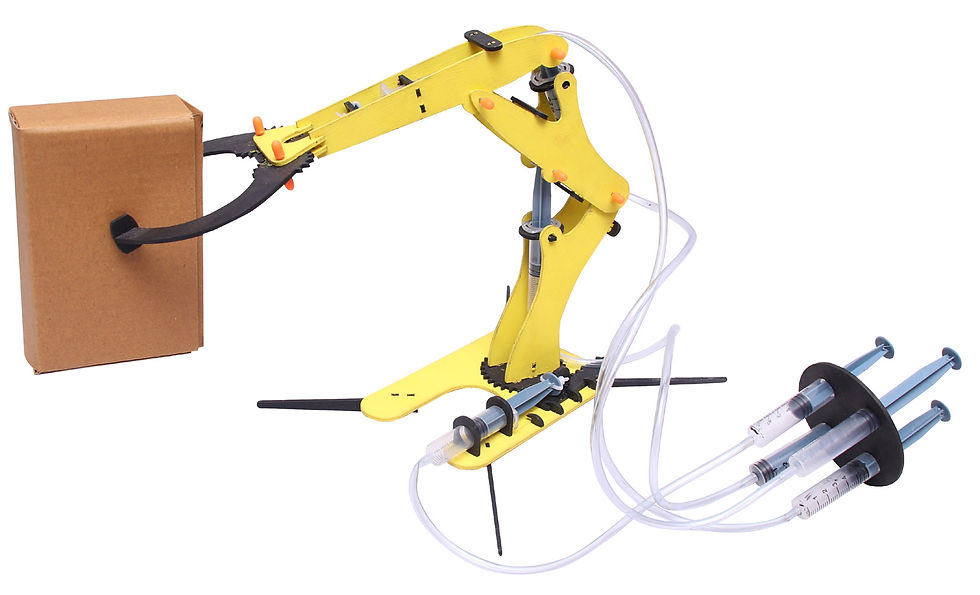HYDRAULIC GRIPPER - DIY kit for Students
Updated: May 1
The science behind hydraulics is called Pascal's principle.
Pascal’s principle, also called Pascal’s law, in fluid (gas or liquid) mechanics, statement that, in a fluid at rest in a closed container, apres sure change in one part is transmitted without loss to every portion of the fluid and to the walls of the container. The principle was first enunciated by the French scientist Blaise Pascal.
Hydraulics in practice: There are several other areas where hydraulics are applied. They are: Automobile garage, Petrol pumps, Measuring weights of heavy-lift trucks, Hydraulic cranes, Automobile steering gears, Automobile brake, (disc brakes), Ship's steering gear, Robotics, Aircraft's rudder and other maneuvering systems, Industries and power plants,Servo mechanisms and control systems etc.
A gripper is a device which enables the holding of an object to be manipulated. The easier way to describe a gripper is to think of the human hand. Just like a hand, a gripper enables holding, tightening, handling and releasing of an object. A gripper is just one component of an automated system A mechanical gripper is used as an end effec tor in a robot for grasping the objects with its mechanically operated fingers. Mechanical Gripper. A mechanical gripper is used as an end effec tor in a robot for grasping the objects with its mechanically operated fingers.Pneumaticgrippers, as the name proposes, works with compressed air. The gripper is connected to a compressed air supply network.When air pressureis applied on the pistons,the gripper closes. The piston will then apply a force according to the pressureon the piston (Force = Pressure * Surface)
FOR YOUR INFORMATION
RACK AND PINIONGEAR MECHANISM
Sometimes, the best way to move something is to drive a gear rack with a pinion. Rack and pinion gear sets are designed to convert rotational motion into linear motion.The circular gear (call the “pinion gear“) engages the teeth on a linear bar (called the “gear rack“). Rotational motion is applied to the stationary pinion gear, which causes the gear rack to move. Thus, the rotational movement of the pinion gear is transferred to the linear motion of the gear rack. Gear Racks the gear rack is a long, straightbar with teeth along its entire length. The teeth have the same pitch as the pinion gear which engage swith it.
Pinions Asthepiniongearisturned,itsgearsmeshwiththegearrack, creating line artorque
Note : The closer to the edge you attach your hydraulic syringe, the more tension (because of the intense angle) you will put on the tube to pop out of the syringe. It’s important to remember what force is pushing the Syringe. The upward force is from the syringe plunger pushing the Gripper Jaw Open. So when you insert your hydraulic system, make sure the syringe that is attached (not the one you push down on with your finger)is empty when the Gripper Jaw is close.
Note : Make sure there are no leaks between the syringe and the tube connection. Your Hydraulic gripperis ready…. Observe what happens… You can see hydraulics at work in this Gripper. To operate, you push in the syringe with water, so that the connected empty syringe moves up the piston... this in turn pushes the Arms in upward direction, Rotating Disk will rotate and Gripper Jaw will open to hold something. Depending which syringe you push makes that part of the Arms moves in upward direction , Rotating Disk will rotate and Gripper Jaw opens. When you will Pull the Syringe Arm will move downward , Rotating Disk will rotate and Grippe Jaw will be closed. Hydraulics utilizes liquids through varying pipes and channels to move large amounts of weight. We have used Flexible pipes and Cylinder (Syringe). When we push the Syringe, it pressurizes the water in the Syringe and Arms moves in upward direction, Rotating Disk will rotate and Gripper Jaw opens.



Comments